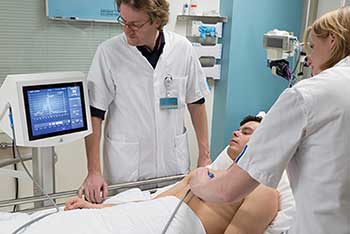Optics and photonics technologies are particularly well-suited for clinical use given their capacity for noninvasive diagnosis, therapy and treatment. Medical applications continue to expand from optical coherence tomography and imaging to optical fibers and lasers for surgery, and now the explosion in wearable devices.
 Medical optics is big business. The global market for medical device technologies is expected to reach $538.7 billion in 2018, registering a compound annual growth rate (CAGR) of 5.5 percent over five years, according to market analysts at BCC Research.
It’s not just patients and health-care professionals who are creating the demand — an emerging trend in wearable medical devices is set to flood the market in the coming years. Such devices are being created to track and analyze information about a person’s health, from respiration rates to glucose levels. This data can be remotely transmitted and provided to medical personnel who could then provide targeted treatment.
According to a Research and Markets report (ID: 3548489) published in January 2016, the global wearable medical devices market is poised to grow at a CAGR of more than 20 percent in the next five years to reach approximately $14.2 billion by 2020.
But just how do device manufacturers gain a slice? Barriers to market for higher-risk medical devices include product trials, clinical trials and finally clearance/approval that is region-specific. All this before persuading the often overworked, time-poor health-care workers to adopt a new way of working or come to grips with a new device.
Medical optics is big business. The global market for medical device technologies is expected to reach $538.7 billion in 2018, registering a compound annual growth rate (CAGR) of 5.5 percent over five years, according to market analysts at BCC Research.
It’s not just patients and health-care professionals who are creating the demand — an emerging trend in wearable medical devices is set to flood the market in the coming years. Such devices are being created to track and analyze information about a person’s health, from respiration rates to glucose levels. This data can be remotely transmitted and provided to medical personnel who could then provide targeted treatment.
According to a Research and Markets report (ID: 3548489) published in January 2016, the global wearable medical devices market is poised to grow at a CAGR of more than 20 percent in the next five years to reach approximately $14.2 billion by 2020.
But just how do device manufacturers gain a slice? Barriers to market for higher-risk medical devices include product trials, clinical trials and finally clearance/approval that is region-specific. All this before persuading the often overworked, time-poor health-care workers to adopt a new way of working or come to grips with a new device.
Member Exclusive: To read the complete article, please Login or Register